#carolina wild petunia
Explore tagged Tumblr posts
Text

Ruellia carolinensis / Carolina Wild Petunia at the Sarah P. Duke Gardens at Duke University in Durham, NC
#Ruellia carolinensis#Ruellia#acanthaceae#Carolina wild Petunia#Carolina ruellia#Native plants#Native flowers#Wildflowers#Plants#Flowers#Nature photography#photography#photographers on tumblr#Sarah P. Duke Gardens#Duke Gardens#Duke University#Durham#Durham NC#North Carolina#🌺🌻#Foliage#Petunia
25 notes
·
View notes
Text



Genus Ceratina - Small Carpenter Bee on a
Carolina Wild Petunia (Ruellia caroliniensis)
#nature#small carpenter bee#backyard nature#bee#nature photography#carolina wild petunia#wildflowers#insects
4 notes
·
View notes
Text
The Beautiful Carolina Petunias Are All Grown Up Now
The Beautiful Carolina Petunias Are All Grown Up Now shows some summer wild Carolina petunias and compares them to some seen in the springtime. It also explains why these flowers have thrived in Florida this year.
Pretty in Purple Back in the spring I wrote about some wild Carolina petunias (Ruellia caroliniensis) that I had seen on the road to my house. Since then, I have been seeing them all over the place. There were a bunch of them outside my office, and they are all over the trails in Gothe State Forest behind my house. I have noticed that as the summer has progressed, the plants have gotten larger…

View On WordPress
#beautiful wildflowers#Carolina petunias#colorful petunias#colorful wildflowers#drought tolerant wildflowers#Florida wild petunias#Florida wildflowers#petunia photographs#petunias#photography#purple petunias#purple wildflowers#summer wildflowers#wild Carolina petunias#wild petunias#wildflower photographs#wildflower photography#wildflowers
0 notes
Text
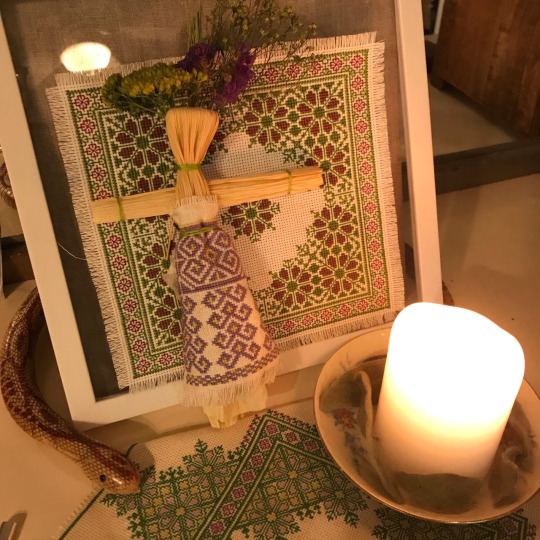

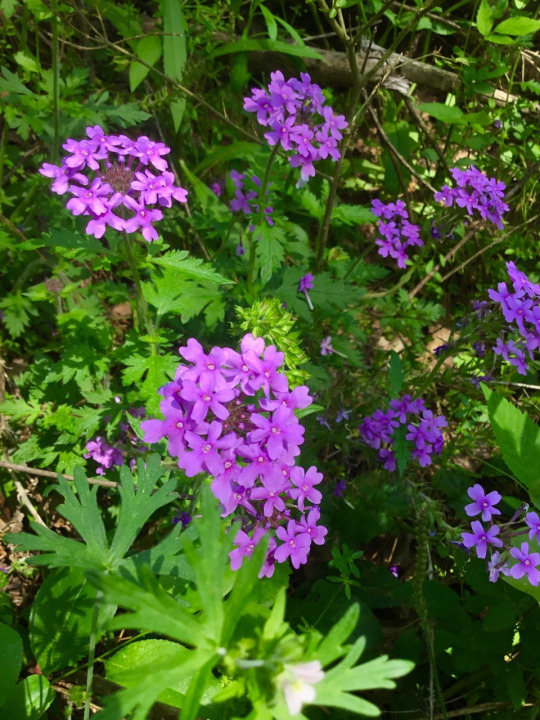

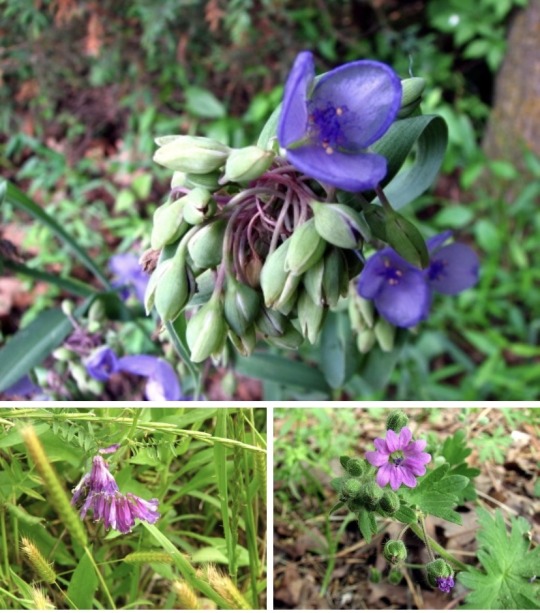
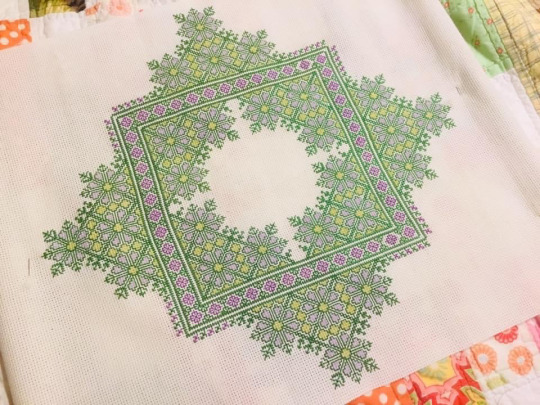
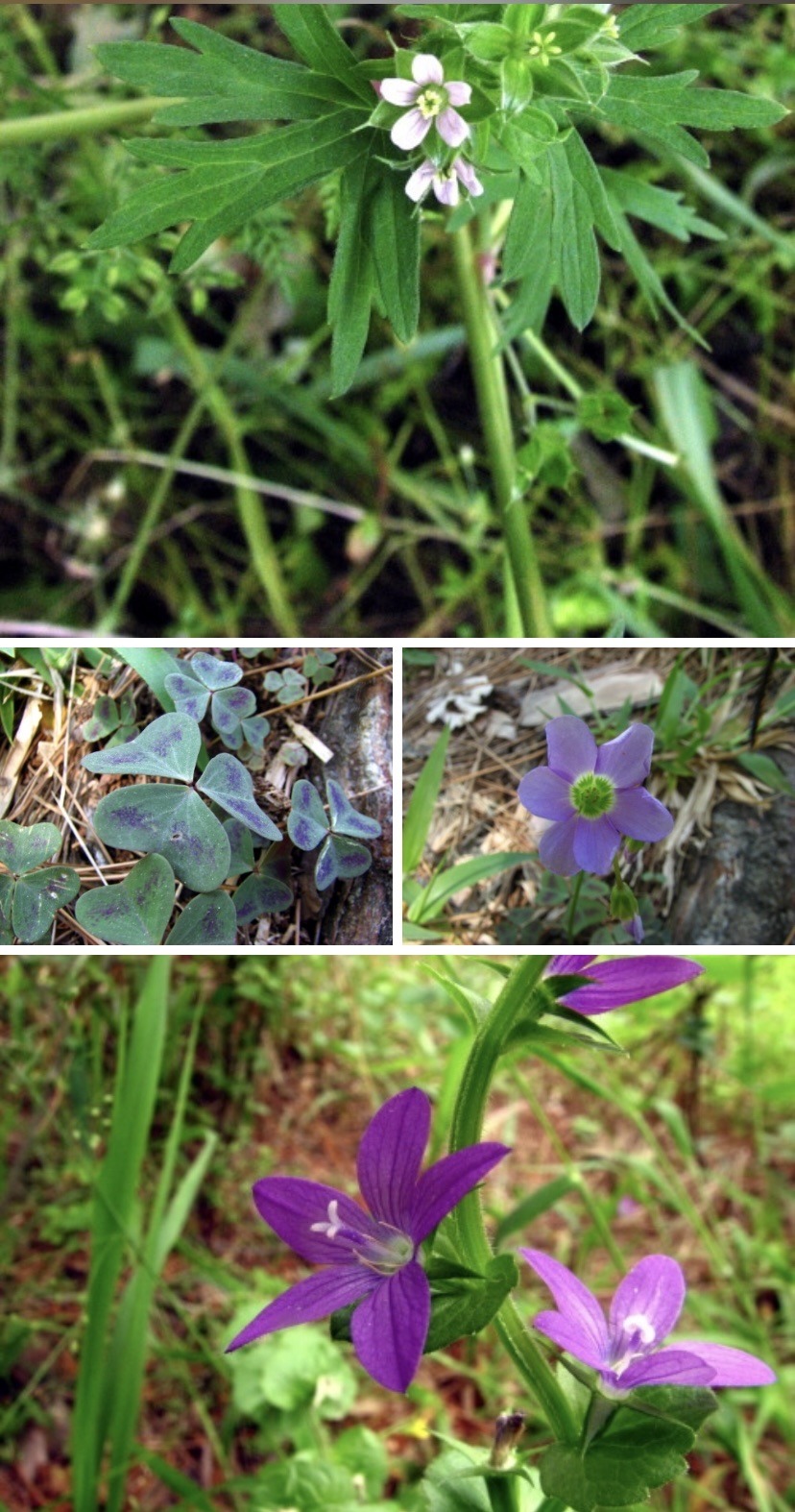
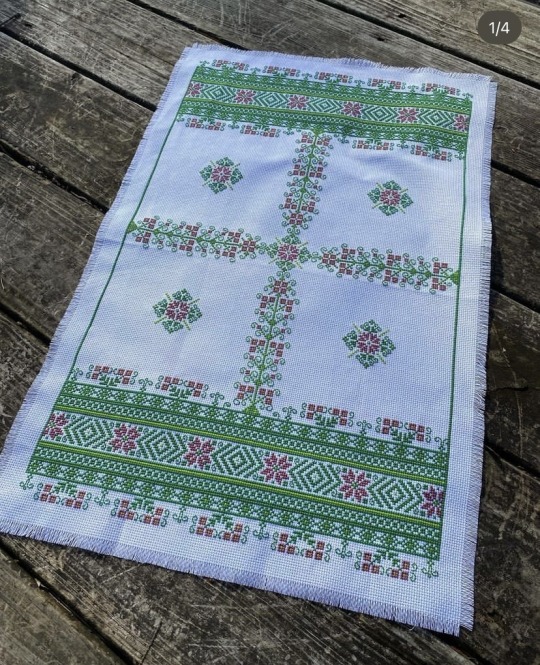

The May Eve/Walpurgisnacht/Hexennacht/Pálení čarodějnic embroideries and the wildflowers that inspired them.
Ratany, verbena, spiderwort, hairy vetch, doves-foot cranes-bill, Carolina geranium, violet wood sorrel (2 pictures, leafs followed by bloom), Venus’ looking glass, cut-leaf tooth cup, and wild petunia.
#Pálení čarodějnic#Walpurgisnacht#hexennacht#may eve#devotional embroidery#folk embroidery#May Queen#Arkansas River Valley#Ozark foothills#wildflowers#purple#green#cross stitch
61 notes
·
View notes
Text
My niece and I did more guerrilla gardening today! She goes to college at the campus where I work, and I always pass this planter that looks so neglected. I brought a bunch of native plants from my garden at home: yarrow, black eyed Susan, Carolina wild petunia, violet, blue mist flower, and lyre leaf sage. We also made plant tags with English and Latin names so it will look sort of official. The soil was worse than I expected (probably all the nutrients soaked up by the willow oak), but I chose plants that are pretty tough, and I can give them some fertilizer later. Since I pass it nearly every day I can keep an eye on them. I hope they’ll grow and bloom!
PS Our plant pirate name is Plant Parenthood, and our theme song is Seoul Town Road because we used my homi (which is my favorite garden tool!)
EDIT a year later: Only one or two plants remain. Very shortly after we did our planting, construction began next door and workers used the flowerbed as a walkway and a place to leave their gear everywhere. Everything was destroyed except one tough lyre leaf sage and possibly one black eyed Susan that's still struggling. Augh! I haven't had the heart to try again. Also I think that soil is probably shot.





72 notes
·
View notes
Text
Carolina Wild Petunia
Carolin Wild Petunia
Coastal Discovery Museum-Hilton Head Island South Carolina Wild Petunia Wild Petunia flower marker Have a happy day 🙂 Alice To view more beautiful flowers click here Cees flower of the Day

View On WordPress
0 notes
Text

petunias
#petunias#petunia#Carolina wild petunias#Carolina wild petunia#wild petunias#wild petunia#naturecore#witchcore#cottagecore#nature#forestcore#forest#nature hikes#springtime#nature photography#flowercore#flower aesthetic#purple flower#purple flowers#flowers#flower#wildflower#wild flower plants#wild flowers#flower photography#photography#forest photography#forest aesthetic#aesthetic#green leaves
4 notes
·
View notes
Text
Floriography Masterpost
Abraham’s Balm - Coldness, Command
Adder’s Tongue - Jealousy
Adonis Vernalis - Bitter Memories
Achillea - War
Aloe - Superstition
Anemone - Estrangement, Forsaken, Brevity, Sickness
Anemone Field - Sickness, Illness
Anemone Garden - Forsaken, Withered Hopes, Illness
Apocynum - Falsehood, Deception
Basil - I Hate You
Bee Balm - Your Whims Are Unbearable
Begonia - Beware, A Fanciful Nature
Belvedere (Wild) - I Declare Against You
Bilberry, Whortleberry - Treachery
Borage - Bluntness
Bramble, Dew Berries, Black Berries - Lowliness, Remorse
Briers - Envy
Bouquet Of Withered Flowers - Rejected Love
Bugloss - Falsehood
Burdoc, Beggar’s Buttons - Importunity
Candytuft - Indifference
Carnations (Stripeed, Yellow) - Rejection, Disdain, You Have Disappointed Me
Carnation (Purple) - Capriciousness
Catalpa Flower - Beware Of The Coquette
Cherry Blossom - False Hopes
Chrysanthemums (Yellow) - Dejection, Slighted Love
China (Pink) - Aversion
Clematis - Artifice (Deception, Trickery)
Clotbur - Rudeness
Coboea - Gossip
Convolvus Major, Bindweed - Dead Hope
Colt’s Foot - Justice Shall Be Done You
Columbine - Folly
Coxcomb - Foppery
Creeping Cereus - Horror
Crown Imperials - Arrogance, Pride Of Birth
Cyclamen - Resignation And Good-Bye
Daffodils - Vanity
Dahlia - Instability
Darnel - Vice
Deadly Nightshade - Falsehood
Dendrobium - Selfish Beauty
Dodder - Meanness
Dragon’s Wort - Horror
Dogbane - Falsehood, Deception
Flytrap - Deceit
Foxglove - Falsehood, Deception
Fritillaria, Guinea-Hen Flower - Persecution
Fraxinella, Cultivated Dittany, Gas Plant - Fire
Furze - Anger
Geraniums (Horseshoe) - Stupidity
Harebell, Campanula - Humility, Grief
Helenium, Sneeze Weed - Tears
Hellebore - Scandal
Hemlock - You Will Be The Death Of Me
Hyacinth (Purple, Yellow) - Jealousy
Hydrangea - Frigidity, Heartlessness, Boastfulness
Ice Plant - Your Looks Freeze Me
Laburnum - Forsaken
Larkspur (Pink) - Fickleness
Larkspur (Purple) - Haughtiness
Laurel - Treachery
Lavender - Distrust
Lettuce - Cold-Hearted
Lichen - Dejection, Solitude
Licorice - I Declare Against You
Lily (Tiger) - Pride
Lily (Orange) - Hatred
Lily (Yellow) - False And Gay, Falsehood
London Pride - Frivolity
Lythrum, Loosestrife - Pretension
Madder - Calumny, Slander
Manchineel - Falsehood, Deception
Mandrake, May Apple, Devil’s Apples, Satan’s Apples - Horror
Marigold - Cruelty In Love, Despair, Grief, Jealousy, Vulger Minded
Meadow Sweet - Uselessness
Milford - War
Mistletoe - You Are A Parasite
Mock Orange - Counterfeit
Monk’s-Hood, Monk’s-Head - Beware, A Deadly Foe Is Near, Danger Is Near
Morning Glory - Coquetry
Mourning Bride - Unfortunate Attachment
Mush Plant - Weakness
Narcissus - Vanity, Self Love
Nettles - Slander, You Are Spiteful
Night-Blooming Cereus, Queen-Of-The-Night - Transient Beauty
Night Shade - Bitter Truth
Nuts - Stupidity
Oleander - Caution, Beware
Orange Lillies - I Hate You
Orange (Mock) - Deceit
Pennyroyal - You Had Better Go
Peony - Anger
Petunias - Resentment, Anger
Pink (Indian) - Aversion
Primrose (Evening) - Inconsistency
Quaking Grass - Agitation
Quamoclit - Busybody
Queen Of The Meadow - Uselessness
Queen’s Rocket - You Are The Queen Of Coquettes, Fashionable
Quince - Temptation
Rhododendron - Danger, Beware, I Am Dangerous, Agitation
Rocket - Rivalry
Rose (Black) - Foreshadow Of Death
Rose (Carolina) - Love Is Dangerous
Rose (Dark Crimson) - Mourning, Bashful Shame
Rose (Dried White) - Death
Rose (Garland Or Crown) - Beware Of Virtue
Rose (Withered White) - Transient Impression, Fleeting Beauty
Rose (Yellow) - Decrease Of Love, Jealousy
Rose (York & Lancaster Together) - Conflict
Scabious, Mourning Bride - Widowhood, Unfortunate Love
Sardonia - Irony
Snapdragon - Falsehood, Deception
Sorrel - Wit Ill-Timed
St. John’s Wort - Superstition
Straw (Broken) - Broken Agreement
Sunflower (Tall) - False Riches, Pride
Sweetbrier (Yellow) - Decrease Of Love
Tansy - I Declare Against You
Thistle - Austerity, Sternness
Thistle (Fuller’s) - Misanthropy
Thistle (Scotch) - Retaliation
Thornapple - I Dreamed Of Thee, Deceitful Charms
Thorn (Black) - Difficulty
Thorns - Severity
Thornapple - Deceitful Charms
Throatwood - Neglected Beauty
Tiger Flower - May Pride Befriend Thee
Touch-Me-Not, Jewel Weed, Impatiens, Balsam - Impatience
Tuberoses - Dangerous Pleasures
Tulip (Yellow) - Hopeless Love, No Hope For Reconciliation
3 notes
·
View notes
Link
TO PLANT their flower and vegetable gardens, African American women used their hands—darkly creviced or smoothly freckled; their arms—some wiry, others muscled; and their shoulders and backs—one broad and another thin. They dropped small seeds into the soil with their veined hands. They wrapped their arms around freshly cut flowers to decorate tables in their homes. They bent their shoulders and backs to compost hay, manure, and field stubble, and transplanted plants from the woods into their own yards. These women developed a unique set of perspectives on the environment by way of the gardens they grew as slaves and then as freedwomen.
They continued these practices and exercised these perspectives into the early twentieth century. Rural African American women then joined these traditional ways of gardening with horticultural practices they learned from Home Demonstration Service agents and from the special programs developed in African American schools in the South.
An examination of these traditions and practices of gardening changes the reading scholars have had of African American participation in Progressive-era agricultural reform and also reveals the outlines of a rural African American environmental perspective at the time. Progressives envisioned national agricultural reforms that subjugated the discrete and nuanced expertise of local actors to models of bureaucratic efficiency and skill. Yet African American women developed an expertise from community knowledge, from their own interpretations of agricultural reforms, and from the training they received in horticulture in the Cooperative Extension Service, African American schools and other places. Progressive era scholars have missed the critical role of African American women gardeners in Progressive reform efforts, or at least have not viewed the participation of African Americans in these efforts through the critical lens of gender.2
These women cultivated with simple tools, a hoe, trowel, or shovel in one hand and seeds or fertilizer in the other hand. But they gardened within a gendered and racial milieu that gave the application of these simple instruments of skill a complex social potency. Rural African American women and men often supported one another in complementary roles and with strategies that were designed to support the family unit. Some women met their own and sometimes their family’s needs by harvesting vegetables for meals, and by planting shrubs and cultivating flowers to create more appealing homes.
The value of the women’s contributions to household productivity was often invisible to Progressive reformers, who practiced enormous condescension in their efforts to uplift the poor. African American reformers shared this condescension, making women special objects of disdain. Thomas Monroe Campbell, an agent for the Negro Cooperative Service, was haughtily dismissive of rural women, characterizing them as “too careless as to the loud manner in which they act in the streets and in public places ... and unduly familiar with men.”
But ultimately, African American women in the rural South controlled how and where they gardened, and by implication, why they gardened. They drew upon rich traditions of gardening knowledge and took what they would from Home Demonstration Work and the education programs of African American schools.This article explores this relationship between African American gardening and Progressive reform, but also asks how African American women cultivated their own gardens. Were African American women’s gardens expressions of self-interest or community experience and values, or both? Did the women blend community and Progressive influences in the gardens they made and used? How did the gardening practices of African American women in the early twentieth century rural South add up to an environmental ethic?3
[...]
THE AFRICAN AMERICAN GARDEN
AFRICAN AMERICAN and Euro-American gardens also possessed distinctive characteristics much like the roles of African American men and women. Though Vera Norwood argues that women of both groups were “responsible for designing and maintaining the yard and its ornamental garden” according to gender, ethnicity was as important as gender in shaping the unique gardens of African Americans. These featured flowers, shrubs, trees, and plants that were purchased individually, accepted as gifts, or cultivated from cuttings. African Americans created colorful motifs from gifts and cast-offs. Euro-Americans could more readily buy several plants and group and organize them.
African Americans relied on an oral tradition, unlike Euro-Americans whose expertise came from magazines and books. African American traditions were so ingrained that plants presented as gifts were associated with the giver.7African American women manipulated and controlled their yards for multiple functions in slavery and then in freedom. Free range in which livestock could roam, or a pen, an extended kitchen from the house, cleaning and leisure spaces, swept areas, and pathways to the fields, woods, the slaveholder’s house, and fenced flower and vegetable gardens comprised overlapping spaces in the yard. Each function, each space was often fluid with little or no boundaries.
Unlike most slaves, renters and owner-operators had some income and could purchase livestock, including chickens and hogs that were given free range of the yard.The women sought the shade and protection of trees from the sun and heat to prepare meals, feed and entertain family and friends, scrape pots, scrub dishes, wipe tables, beat rugs, and launder clothing. Children played and adults sought recreation throughout the yard, particularly in the shade. Outside the green spaces, women carefully swept clean any foliage, including weeds, creating a bare and austere yard.
The pathways took the women beyond their homes and yards to the environs of the woods, fields, the big house, neighbors, and town.8 In these gardens, African American women planted vegetables, fruit, flowers, shrubs, trees, and plants in red clay, sandy, and dark loamy soils. They generally cultivated vegetable gardens on a side or to the back of the cabin for easy access. To keep out livestock, their partners probably built enclosures of tied stakes for gardens—less expensive than free range. Most women grew vegetable gardens primarily to sustain their families.
[...]
They planted okra, milo, eggplant, collards, watermelon, white yam, peas, tomatoes, beans, squash, red peppers, onions, cabbage, potatoes and sweet potatoes. Others planted truck gardens and sold corn, cotton, peanuts, sweet potatoes, tobacco, indigo, watermelons, and gourds at the market for profit. African Americans also displayed flowers for everyone’s viewing and pleasure, beckoning neighbors to take a closer look or visitors to chat in the yard’s fragrance and color.
The women looked out upon exquisite flowers including petunias, buttercups, verbenas, day lilies, cannas, chrysanthemums, iris, and phlox planted in the ground, old tires, bottles, planters, and tubs. They placed shrubs—roses, azaleas, altheas, forsythia, crepe myrtle, spirea, camellias, nandina, and wild honeysuckle—throughout the yard. Azaleas and roses were most commonly planted. The dogwood, oak, chestnut, pine, red maple, black locust, sassafras, hickory, willow, cottonwood, and redbud dotted the landscape. They chose ornamental plants that were self-propagating, along with annuals that were generally self-seeding.
Colorful combinations of blues, reds, pinks, oranges, whites, and yellow often clashed with little or no sequencing. Placement was generally informal, where the gardeners could find space. A mix of color and placement resulted in a lack of symmetry and formal design. African Americans, including the women, simply could not afford to buy several shrubs, plants or flowers at the same time to create such symmetry.9 Women’s roles were transformed from slavery to sharecropping. Jacqueline Jones observes that African American men reinforced gender roles by hunting and fishing during slavery. Men were primarily responsible for cultivating the tiny household garden plots allotted to families by the slaveholder.
They practiced conservation, tilling their own vegetable plots when time off from the slaveholder’s tasks allowed. Dating back to the antebellum period, slaves used organic farm methods such as composting, when they took or were given the opportunity to grow their own gardens. A Louisiana slave gardener also built birdhouses from hollowed gourds to attract nesting birds that protected vegetables from insects and other pests.The birdhouses, a modern fixture in suburban backyards, provided shelter for the birds that served as a natural pest control.
[...]
GARDENING IN AFRICAN AMERICAN SCHOOLS:
African American schools offered several options to their students including model yards and classes with practical and aesthetic applications. The school trained students on school grounds by cultivating model yards for teaching and profit. The model yards featured traditional elements found in a rural African American culture, including gardens, livestock, and laundering. Schools like Tuskegee and Hampton Institute also offered home economics classes, which included gardening training for women, and an agricultural curriculum for men. Most significantly, African American women teachers taught other women to cultivate aesthetically pleasing gardens.
Some applied their training to teach at secondary schools. In 1937, the African American Elizabeth City State Normal Summer School in North Carolina offered a class in housing titled, “The Rural Community Background and Rural School Organization and Management,” which emphasized home and yard aesthetics in the curriculum, and suggested “ways and means of making rural life more attractive and joyous to those who live in the open country.” Students sketched “attractive lawns and backyards and [gave]suggestions of what native shrubbery to use and when to transplant it” in this class.
They created images of nature in their art and searched the woods for plants to dig up, carry home, and replant.27 Progressive influences continued at Hampton which offered to African American women courses with aesthetics in mind, ranging from “Flower Arrangement” to “Landscape Design” in the “Curriculum for the Division of Agriculture.” These courses nurtured creativity through symmetry and beauty. Hampton also offered “Flower Arrangement” and “Flower Growing for Amateurs”— classes focusing on aesthetics and scientific housekeeping already practiced in the community and Home Demonstration.
In the flower arranging class, teachers taught “the fascinating art of flower arrangement [that] provides a medium of expression universal in appeal. Students in all divisions of the Institute will find value in learning to utilize plant materials in home, store, school, or office decoration.” Instructors demonstrated “the necessary methods involved in knowing and growing ornamental plants commonly used about the home can well be learned with study and practice” in “Flower Growing.” As teachers, Home Demonstration agents, or homemakers, women applied scientific housekeeping to gardening.28Hampton also offered classes in advanced gardening.
Teachers there taught “Ornamental Horticulture,” a course general enough in scope for the layperson and the horticulturist. Students, both men and women, learned to arrange and enhance “the homes and grounds and larger properties in order to make them more useful as well as attractive” while “growing and caring for trees, shrubs, and flowers as a commercial enterprise or as a hobby.” One of the courses, "Landscape Design of Small Properties,” was more advanced than basic flower planting and arranging, and taught vegetable gardening with an emphasis on aesthetics: “Landscaping one’s own home or school grounds is an economy and a pleasure as well as an art.
Teachers, community workers, and home owners alike will find it much to their advantage to be able to improve their surroundings in their respective communities.” In the “Landscape Gardening” class, students learned “the practical methods of beautifying grounds around the buildings, the construction of wind breaks, placing ornamental flower beds, laying out walks, planting trees and shrubs, arranging and planting window boxes.” Once again,African Americans had the opportunity to layer Progressive horticultural education upon community experiences.29
2 notes
·
View notes
Photo

Carolina Wild Petunia (white)
1 note
·
View note
Text
Carnivorous Plants and the Things I Know About Them
I've been kicking around the idea of making a post like this and I figured it was of enough general interest to folks on Tumblr to go for it.
So
One of the things I do is grow carnivorous plants, like these
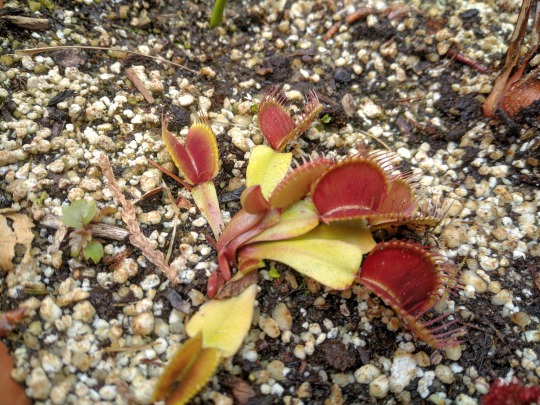
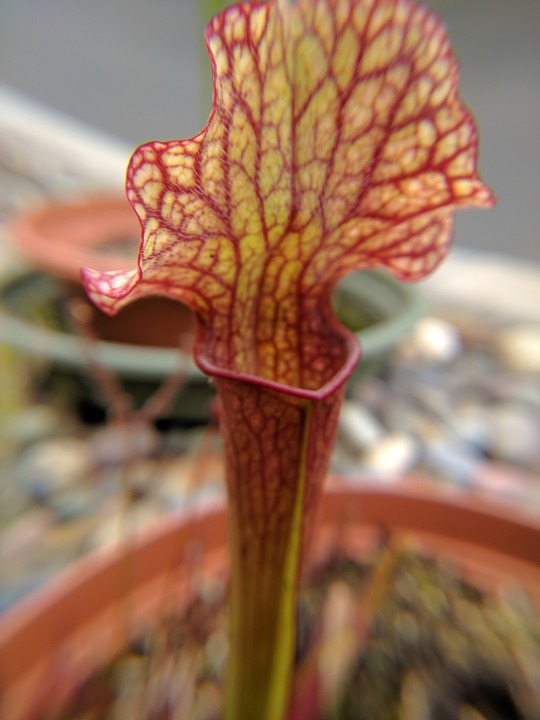
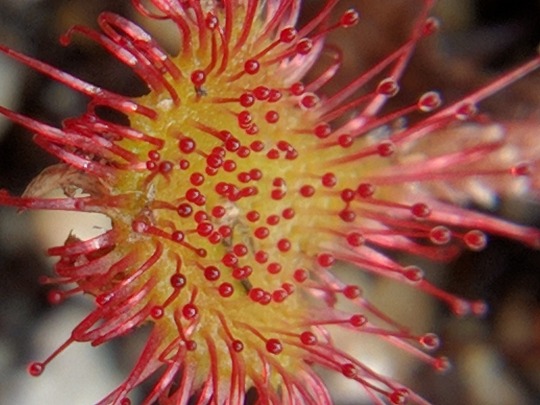

From top left to bottom right we have a Venus Flytrap, a North American Pitcher Plant, a Sundew, and a Butterwort. All of these are pictures I've taken of plants during the growing season.
Now if you look at these weird looking plants you probably wouldn't expect them to be native to North America, but they are. You can find pitcher plants all over the southeast up to the northeast into Canada, flytraps in the Carolinas, and butterworts and sundews all over the continent.
These plants are a lot of fun and easy to grow once you understand their requirements, but before we get into that, I want to take a moment and explain how they came to be in the first place.
To keep it short, carnivorous plants are carnivorous because they grow in soils that are lacking in the nutrients plants need to put out new growth. Because of this, they evolved to find their nutrients a different way - by luring, trapping, and digesting insects. While these plants still photosynthesize, they supplement this with the nutrients they absorb from insects.
Now that we've got that out of the way, I'm going to go into the basics of growing them, point by point. A short disclaimer - I'm specifically talking about temperate North American plants, since they're what I have experience growing. I can provide basic info on how to take care of tropical plants like the southeast asian pitcher plants, but as of this post I don't have experience with them yet.
Soil: For carnivorous plants, a good soil mixture is a must. These plants grow in nutrient-poor marshes, and the soil they call home is constantly wet. The main ingredient in basically any carnivorous plant soil mix is sphagnum peat moss, which is slightly acidic. The second part of the mixture is often perlite or horticultural sand. Some nurseries use a mix of equal parts peat and perlite while others use 80% peat and 20% perlite, but I've had success with both. The most important thing to ensure is that your soil doesn't have any fertilizer added to it. Because carnivores grow in low nutrient soil, any kind of medium that contains fertilizer can actually kill them.
Water: The other vitally important part of the equation (and the one that kills lots of plants when incorrectly applied) is water. Generally, unless your tap water is soft, water carnivores with distilled or reverse osmosis water. The minerals in tap water or even bottled drinking water can eventually build up and kill your plant in the same way fertilized soil does. Carnivores love waterlogged soil, and some even get flooded in nature. To approximate this, set your plant in a tray of water no more than an inch or two high. This ensures your soil stays wet without having to constantly water it.
Containers: Plastic pots are your friend. Avoid terra cotta clay pots, since they can leech minerals into the soil and also tend to dry out your substrate faster. Glazed clay containers can also work. If you're using the tray system, make sure to buy pots with drainage holes, so the water can get in. Also, a trick that lets the water in but keeps the soil from escaping is to line the bottom of the pot with long-fibered sphagnum moss. If you go with an undrained container, make sure to keep the soil wet at all times, but allow some of the water to evaporate in order to keep the water table fluctuating.
Sunlight: Since carnivores evolved their leaves to catch insects, they're pretty poor at photosynthesis. As a result, these plants love sun - the more the better. Many a store bought flytrap has perished as a houseplant due to lack of sun, so if you can, put these plants outside, in the sunniest spot you can. Generally, it's good to give most carnivores around 6 hours of sunlight per day. Many can get by with 4, but they don't often thrive with that amount of light.
Dormancy: Plants that grow in temperate or warm temperate climates tend to buckle down and hibernate during the late fall and winter months, conserving energy until spring. Generally speaking, the large traps die off, or in some cases the plant dies down to the roots, or forms a small bud that rests on the ground. Plants grown outside respond to colder temperatures and shorter photoperiods, while plants grown inside usually need some help. If you're growing your plants on a windowsill or in a terrarium, move them somewhere cold or cut down on their heating, and also diminish the amount of daily light they receive. You can also slow down on watering, though they still need some water to get by.
Temperature: Temperate and warm temperate carnivores can tolerate a wide range of temperatures, despite what you might think. My pots survived the freak snowstorm the Pacific Northwest got this February without a single dead plant. Most species can tolerate temperatures up to 100 degrees Fahrenheit and down to 20 degrees, though not for prolonged periods of time. If you see long spells of hot or cold weather coming, try and move your plants to a protected area until they pass.
Feeding and Fertilizing: Now I know what you're thinking. Fertilizer? He just told us that stuff was death! And it often is, but there are ways to fertilize your plants. Generally, a fertilizer made for acid-loving plants can be diluted and applied to the leaves during the growing season. I use Maxsea 16-16-16 on plants that are too young to easily catch prey (diluted down to a half teaspoon per gallon) and haven't had issues. Try not to spray the soil unless you frequently water your plants from overhead, as the dreaded mineral buildup can still occur. That said, if your plants are outside, they'll fertilize themselves. You can also "feed" your plants insects using tongs - keep in mind that some plants require their prey to be alive in order to secrete digestive enzymes. I'll get into prey in more detail in other posts about specific types of plants.
Flowering and Propagation: For a lot of carnivorous plants, flowering is an exhausting effort that tends to deplete the energy they would use creating traps. As a general rule, if you're not interested in seed, clip the flower stalks off. Many plants can be propagated through leaf or root cuttings, which produce genetically identical plants. Some plants also clump and form their own divisions over time, meaning all you need to do to get more is wait for a year or so, depending on the age of the plant.
Pests: Carnivores can be targeted by various pests. For insecticides, I've seen neem oil recommended, as its generally less harmful to the plant and the environment. I haven't had to make much use of these yet, so my information on insecticides is a bit of a blind spot. Generally, try and stay away from soap insecticides and aerosols, and stick to less concentrated varieties. If you're dealing with squirrels or rodents digging up your plants, I found a generous sprinkling of cayenne pepper around the plants works wonders, and does no harm to the plants.
This is a basic rundown of carnivorous plants and how to take care of some of them. I must stress there's a ton of information out there - this post is geared more towards starter plants that are fairly forgiving and simple to grow.
So why grow carnivorous plants when you can just go out and buy some petunias?
They're active: Carnivores are showy, unique plants that can move on their own through some incredibly unique and complex evolutions. Watching a Venus Flytrap snap shut or a Sundew curl around an insect is a truly special thing to see.
They're a conversation piece: The relative rarity of carnivores in cultivation means the average person doesn't know much about them, despite maybe having heard of a Venus Flytrap before. A 12" pot of flytraps, sundews, and pitchers is a surefire way to grab attention.
They can control certain pests: Carnivorous plants can act as natural pest controllers. North American Pitcher Plants gorge themselves on flies and wasps, and considering some pitchers can grow over two feet tall, they can hold plenty of them. Sundews and butterworts specialize in catching smaller prey, such as fungus gnats, fruit flies, and even fleas. These plants can work as limited, natural pest controllers, though they won't eradicate a yellow jacket nest for you.
They're endangered in the wild: The wet, marshy habitats carnivores call home are rapidly dwindling due to improper land management and development. Some are nearly extinct in their home ranges, kept going through dedicated nurseries and attempts to naturalize them in other locations. By caring for carnivorous plants, you're raising awareness of these unique, underappreciated organisms and aiding in their conservation by keeping them alive.
Phew, I realize this was a lot, but I hope it was a fun read! Let me know what you think about carnivorous plants, or if you have any questions about them. I'm going to try and go into more detail on specific plants later, but for now, I wanted to bang out the basics.
If you're looking for more information, Flytrapcare.com is a great forum, and the r/savagegarden subreddit is very helpful as well. For books on the subject, the Savage Garden by Peter D'Amato is the go to source. Nurseries I've used and can vouch for are Sarracenia Northwest (located in Oregon) and California Carnivores (located in California).
26 notes
·
View notes
Text

Ruellia carolinensis / Carolina Wild Petunia at the Sarah P. Duke Gardens at Duke University in Durham, NC
#Ruellia carolinensis#Ruellia#acanthaceae#Carolina wild Petunia#Carolina ruellia#petunia#Native plants#Native flowers#Wildflowers#Plants#Flowers#Nature photography#photography#photographers on tumblr#Sarah P. Duke Gardens#Duke Gardens#Duke University#Durham#Durham NC#North Carolina#🌺🌻#Foliage
7 notes
·
View notes
Text
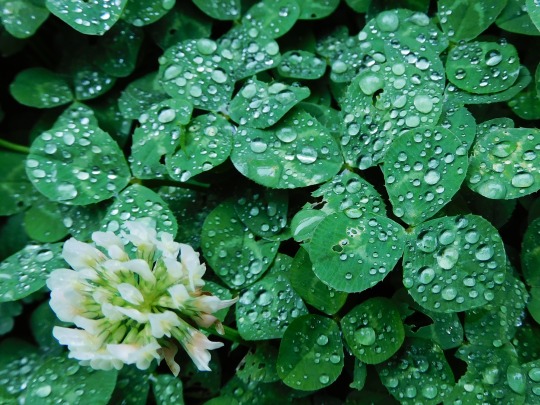






Plants, flowers and even an insect on a rainy day...
#white clover#magnolia blossoms#arum lily#carolina wild petunia#goldenrod soldier beetle#sweet gum#nature#wildlife photography#nature photography#backyard nature
2 notes
·
View notes
Note
Flower ask: also all of them. you get to suffer with me >:3€
oh darlin’ we’re in it now huh
Alisons: Sexuality?
homogay
Amaranth: Pronouns/Gender?
she/they | all gender will be shot on sight
Amaryllis: Birthday?
sept 23rd
Anemone: Favorite flower?
monkshood
Angelonia: Favorite t.v. show?
stranger things or ghost adventures
Arum-Lily: What’s the farthest you’d go for a stranger?
like? distance? a couple miles probably
Aster: What’s one of your favorite quotes?
“We are such stuff as dreams are made on, and our little lifeIs rounded with a sleep.” William Shakespeare, The Tempest
Aubrieta: Favorite drink?
wild cherry capri sun
Baby’s Breath: Would you kiss the last person you kissed again?
ima change that to ‘kiss the last person u thought abt kissing’ bc YES
Balsam Fir: Have you ever been in love?
*jenna marbles voice* hell yeah!!
Baneberries: Favorite song?
waiting for the end - linkin park
Basket of Gold: Describe your family.
chaos
Beebalm: Do you have a best friend? Who is it?
i have too many to list !!! brandi, kasey, you, liz, ivy, nick , just to name a few!!
Begonia: Favorite color?
blue uwu
Bellflower: Favorite animal?
foxes !! and opossums
Bergenia: Are you a morning or night person?
night time babey
Black-Eyed Susan: If you could be any animal for a day, what would it be?
either a fox or an opossum or a raven, i think
Bloodroots: When you were a kid, what did you want to be when you grew up?
i wanted to be a vet !!!
Bluemink: What are your thoughts on children?
theyre ok as long as theyre not screaming and/or mine
Blazing Stars: What are you afraid of? Is there a reason why?
i don’t liike vomit bc. nastey (trauma i think) and i don’t like old ppl well. i dunno why? they’re just so old and fragile and helpless and sometimes they’re really mean and idk i think it’s like something to do w death or something LMAO idk. also i just hate the idea of becoming old and having to rely on other people ?? hhh
Borage: Give a random fact about your childhood.
i was bullied a lot
Bugleherb: How would you spend your last day on Earth?
realistically? probably playing dead by daylight with my girlfriend ADFSGRHYUTR
Buttercup: Relationship Status?
happily taken
Camelia: If you could visit anywhere, where would you want to go?
ireland, scotland, alaska, greece
Candytufts: When do you feel most loved?
whenever my friends or family tells me they love me but esp when u text me goodmorning or when we say our goodnights sorry im gay haha
Canna: Do you have any tattoos?
i have. uuuuhh 6
Canterbury Bells: Do you have any piercings?
no!!! i want some tho :(
California Poppy: Height?
i think im like. 5′5 or something? give or take an inch ?
Cardinal Flower: Do you believe in ghosts?
oh absolutely. my house is haunted as we speak
Carnation: What are you currently wearing?
bmth hoodie and pajama pants w foxes all over them. i just woke up lol
Catnip: Have you ever slept with a nightlight?
yeah i always keep one on in the bathroom
Chives: Who was the last person you hugged?
my sister bc she came home from college yesterday
Chrysanthemum: Who’s the last person you kissed?
ask me in like. a little over a month from now ;)
Cock’s Comb: Favorite font?
FONT??? the animal crossing font
Columbine: Are you tired?
oh absolutely
Common Boneset: What are you looking forward to?
thanksgiving, christmas, seeing my gf, magfest
Coneflower: Dream job?
idk if it’s a job but i just wanna own like. a ranch that takes in all sorts of animals and takes care of them
Crane’s-Bill: Introvert or extrovert?
introvert
Crocus: Have you ever been in love?
ooooh yeah
Crown Imperial: What’s the farthest you would go for someone you care about?
i mean. depends on what they want/need. distance wise? i’d travel the known universe for u
Cyclamen: Did you have a favorite stuffed animal as a child? What was it?
he was a plaid teddy bear his name was Stanley!!!! i miss him :( but now i have Little Moon God as my favourite stuffed animal
Daffodil: What’s your zodiac sign?
Libro
Dahlia: Have you done anything worth remembering?
Working in Yellowstone is something I’ll never forget
Daisy: What do you feel is your greatest accomplishment?
well. hmm. i was gonna say flying to yellowstone but maybe driving to north carolina by myself bc driving long distances alone to places i haven’t been before gives me hella anxiety (i’m better now)
Daylily: What would you do if your parents didn’t like your partner(s)?
i don’t pay rent in this house to listen to their opinions lmao.
Dendrobium: Who is the last person that you said “I love you” to?
you, i think, when we said goodnight last night!!! EDIT: you this morning!!
False Goat’s Beard: What is something you are good at?
being bad at dead by daylight
Foxgloves: What’s something you’re bad at?
dead by daylight
Freesia: What are three good things that have happened in the past month?
(little over a month now but uhhh) GOT A UH ......GIRL.....FRIEND ...... GOT TO VISIT GIRLFRIEND ........ and got the windshield finally replaced in my car
Garden Cosmos: How was your day today?
i dont know! so far ive laid in bed now im at my computer answering this. not too bad. my shift is only 4 hours today.
Gardenia: Are you happy with where you’re at in your life?
for the most part, i’m pretty content, yeah
Gladiolus: What is something you hope to do in the next year or two?
MOVE OUT
Glory-of-the-Snow: What are ten things that make you happy/you’re grateful to have in your life?
my friends, my mom, my sisters, my girlfriend, my bastard dog
Heliotropium: What helps you calm down when you feel stressed?
metal
Hellebore: How do you show affection?
what does this mean. physically, i’m very affectionate, i just. don’t show it alot bc anxiety/i overthink. that and i constantly tell ppl i love them and what they mean to me
Hoary Stock: What are you proudest of?
whoever is reading this
Hollyhock: Describe your ideal day.
wake up next 2 a cute girl. take way too long to get up. go climb mountain w cute girl. vibe on mountain w cute girl. go to waffle house 2gether. gome home and vibe. play video games or watch a movies/tv w cute girl.
Hyacinth: What do you like to do in your free time?
i like to make art or play bideo jame
Hydrangea: How long have you known your best friend? How did you meet them?
oh gosh i dunno. the ones i’ve known the longest are kasey and brandi, and i’ve known them both around/over a decade i think. we met in middle/highschool!
Irises: Who can you talk to about (almost) everything?
you, ivy, liz
Laceleaf: How many friends do you have?
so many
Lantanas: What’s the best compliment you’ve ever received?
idk man but i remember when you said u had a crush on me and then i posted a selfie and u were like ‘OH NO SHE’S CUTE” and like ??? idk i think that was definitely the first compliment to ever shock me LMAO
Larkspur: What do you think of yourself?
6.9/10
Lavender: What’s your favorite thing about yourself?
my tattoos
Leather Flower: What’s your least favorite thing about yourself?
https://www.youtube.com/watch?v=kGGViLwHEUk
Lilac: What’s something you liked to do as a child?
i liked to play zombies ate my neighbors on the sega genesis !!!!
Lily: Who was your best friend when you were a kid?
eliza !!!! we lost touch a few years after i moved away :(
Lily of the Incas: What is something you still feel guilty for?
ima be real everything makes me feel guilty
Lily of the Nile: What is something you feel guilty for that you shouldn’t feel guilty about?
aaaaaa the whole abi/moon incident
Lupine: What does your name mean? Why is that your name?
my name is fox. it means i like foxes
Marigold: Where did you grow up? Tell us about it.
northern virginia babey !!!! that place fucking sucks!!! but everyone who lives up there thinks they’re hot shit.
Morning Glory: What was your bedroom like growing up?
i had a bunkbed and i think the walls were pink
Mugworts: What was it like for you as a teenager? Did you enjoy your teenage years?
😬 i’m just gonna say i’m much happier now and i’m coping with life and shit a lot better
Norwegian Angelica: Tell us about your mom.
she’s sweet and funny and i love her so much!! she always does the Most for everyone, sometimes to the point where she isn’t concerned abt herself and i see where i get it from. but yeah my mom is great, my dad doesn’t deserve her
Onions: Tell about your dad.
source of a lot of trauma and why i have so many issues regarding men. i don’t wanna talk about him anymore LOL he doesn’t deserve the attention
Orchid: Tell about your grandparents.
my dad’s mom is becoming senile and i think she’s racist and queerphobic. my mom’s parents disowned her a few years ago so we don’t talk to them anymore
Pansy: What was your most memorable birthday? What made it be so memorable?
i dunno. i don’t try to remember my birthdays. whenever i can go to busch gardens for my birthday i usually have a lot of fun there.
Peony: What was your first job?
if you don’t wanna count working w my mom as a florist, target was my first job back in 2016. i found my name tag the other day , actually
Petunia: If you’re in a relationship, how did you meet your partner(s)? If you’re not in a relationship, how did you meet your crush/how do you hope to meet your future partner(s), if you want any?
WELL, i know you followed me on here first. and then twitter?? but we didn’t really start talking until stranger things 3 came out (thank u stranger things) PHYSICALLY, we didn’t meet until fursonacon (haha. i remember when u texted me that u got to the hotel and i came down to help n i saw u unloading yr car and it was then that my brain was like OH NOOOOOOOO and my heart was like OH YEEEEAAAAAAAH)
Pincushion: How do you deal with pain?
physical, mental, or emotional? i play a video game or listen to loud music
Pink: Where is home?[
somewhere in appalachia i can feel it in my stupid soul
Plantain Lilies: If you could go back in time, what is one thing you would stop/change?
idk man i’m pretty content w where i’m at now so
Prairie Gentian: Who is someone you look up to? Describe them.
chester bennington
Primrose: Describe your ideal life.
i have a waife and we have many great pets and we live in a log cabin in the mountains or in a nice victorian in a small town or something IDK but we’re happy and that’s all that matters
Rhodendron: What is something you used to believe in as a child?
God
Ricinus: Who’s the most important in your life?
my mom, me best friends, my girlfriend
Rose: What’s your favorite sound?
my girlfriend’s laugh because it’s THE cutest shit and then when she giggles??? oh my heart
Rosemallows: What’s your favorite memory?
oct 23rd, 2005, we brought Fat Boy Zack home !!!!
Sage: What’s your least favorite memory?
July 22nd, 2016. i was 2200 miles away
Snapdragon: At this moment, what do you want?
to be holding my girlfriend >:(
St. John’s Wort: Is it easy or difficult for you to express how you feel about things?
hhhhhhhhhheeeeeeeeeeeeeeeeeeeeeeeeeeeeeeee
Sunflower: What is something you don’t want to imagine life without?
those i hold dear
Sweet Pea: How much sleep did you get last night?
enough, i guess?
Tickseed: What’s your main reason to get up every morning?
my girlfriend
Touch-Me-Not: How do you feel about your current job?
it’s fucking BORING and TOO EASY and they don’t pay me ENOUGH but i can get away with so much shit there so ima still go, ima still go
Transvaal Daisy: What’s your favorite item of clothing?
all of the flannels currently in my possession
Tropical White Morning Glory: Describe your aesthetic.
mountains, woods, forests, cabins, autumn, cryptic, occult, victorian, edwardian
Tulip: What would be the best present to get you?
if someone gets me a gift i’m legally required to execute them
Vervain: What’s stressing you out most right now?
this 40hr workweek i got coming up
Wisteria: How many books have you read in the past few months? What were they called?
i have not read in So Long
Wolf’s Bane: Where do you want to be in life this time next year?
Moved out away from here lol, we’ll see
Yarrow: Do you know what vore is?
:/
Zinnia: Give a random fact about yourself.
i’m a furry
that was SO LONG im sorry i also put you through that but THANK YOU ENJOY READING ILU
8 notes
·
View notes
Photo


Ruellia strepens, the Limestone Wild Petunia
Another classic species found in calcareous glades. This species seems to be notably taller than the other Ruellia spp. for the East-coast/ Midwest, or rather, at least in Ohio, Kentucky, and Indiana it rules the height scale. It only does well with calcareous environments with open-woodlands caused by thin substrate heterogeneity; this said, it has been found a few times in the more open calcareous barren like prairies. The way we can truly tell this species apart is easily remembered by it’s second common name, The Smooth Petunia. Unlike the Carolina and Hairy Petunia, this species is smooth stemmed; there is a var. that has node tufts. I caught this one in June just starting to bloom but, depending on the eco-range you can find them blooming as early as May to the end of October.
Also this individual has the same energy as Horse gentian mixed with a fringe gentian.
5 notes
·
View notes
Text
Sim Families and Names
When I first created them:
The Rivers Family: Oliver, Jasmine, Arthur, Harold and Flora
The Hill Family: Jason, Bethany, Lucas and Tania
The Simpson Family: Aaron, Beatrice, Ruth and Eric
The McCormack Family: Fredrick, Tanusha, Amber and Robin
Floyd: Hector, Isabelle, Maya and Kazuo
The Half-Human/Half-Supernaturals Household: Ebony Way, Alan Thompson, Keanu Thompson and Florence Mather
The Mather Family: Issac, Clara, Janey and Matisha
The Molyneux Family: Saturn, Rhea, Achilles, Medea, Ajax and Daphne
The Mason Family: Yvvonne, Richard, Undyne, Carolina and Jeremy
The Smith Family: Tamora, Ignoitus, Amelia
The Johnson Family: Cepheus, Cassiopeia, Andromeda, Perseus and Orion
The Matthews Family: Francis, Daniella, Naomi and Matilda
The Harris Family: Augustus, Juliana, Clove, Cato and Octavius (Aborted Arc 2 of the original Oakley Legacy family; created to add some diversity into town)
The Molyneux Extended Family: Neptune, Amphritite, Proteus, Teucer, Hercules and Hebe (Originally created to add some gender balance in my town)
Copules:
The Odair Family: Triton, Marina, Finnick and Annie (Finnick and Annie are based on characters from The Hunger Games series)
The Wilson Family: Anneka and Virgil
The Kirkman Family: Thomas and Arianna
The Oakley Family: Dennis and Iris
Born in-game kids:
Smith Family: Promethus, Marius, Canute and Cosima
The Half-Human/Half Supernatural Household: Janus Thompson (Alien Child)
Future Families:
The Appleton Family: Hawthorn, Pansy, Petunia, Larkspur
The Newton Family: Hadrian, Cornelia, Antonia, Regulus
Wild West themed family: Wayne, Rosenda, Kim, James
The Pilkington Family: Parents, teen son Xavier and two daughters
The Green Family: Parents, teen girl and youngest son Neil
The Bolton Family: Parents, Young Adult son Declan and two teen daughters named Lavender and Leah
The Kirkland Family: Parents and teen daughter Xanthe
The ‘O’Callaghan Family: Parents, teen girl named Finch and younger sisters
The Gillibanks Family: Parents, teen boy Anthony and younger brother
The Price Family: Parents, teen boy Falcon and younger son
The Armitage Family: Parents and teen girl Harriet
The Nickelson Family: Parents, teen girl Summer and younger son
The Jones Family: Parents, teen son Isambard and young son
Planned Werewolf Family: Parents and two young children
Planned Witch Family: Parents and three daughters
Single Sims:
Katherine Barlow (Based on the character from “Holes” as a schoolteacher)
Sam The Onion Man (Based on the character fom “Holes”. In his and Katherine’s time period mixed-race relations were heavily frowned upon, and the scandal that erupted when a woman in town caught Sam and Katherine kissing resulted in Sam’s death and Katherine vowing revenge on Sam’s killers)
Emmy Altava (Based on the character from the video game series “Professor Layton”. Traits: Disciplined, Athletic, Photographer’s Eye, Brave, Genius).
Names used:
A: Achilles, Arthur, Amelia, Andromeda, Amphrite, Augustus, Aaron, Amber, Anneka, Arianna, Annie, Ajax, Alan
B: Beatrice, Bethany
C: Cato, Cassiopeia, Cepheus, Clove, Clara, Carolina, Cosima, Canute
D: Daphne, Daniella, Dennis
E: Ebony, Eric
F: Francis, Fredrick, Flora, Florence, Finnick
G: No G names
H: Harold, Hector, Hebe, Hercules
I: Ignoitus, Issac, Iris
J: Janey, Jeremy, Jason, Jasmine, Juliana, Janus
K: Kazuo, Keanu
L: Lucas
M: Matilda, Medea, Matisha, Marius, Marina, Maya
N: Naomi, Neptune
O: Octavius, Orion, Oliver
P: Perseus, Proteus, Promethus
Q: No Q names
R: Richard, Rhea, Ruth, Robin
S: Saturn
T: Tanusha, Teucer, Tamora, Tania, Thomas
U: Undyne
V: Virgil
W: No W names
X: No X names
Y: Yvvonne
Z: No Z names
2 notes
·
View notes